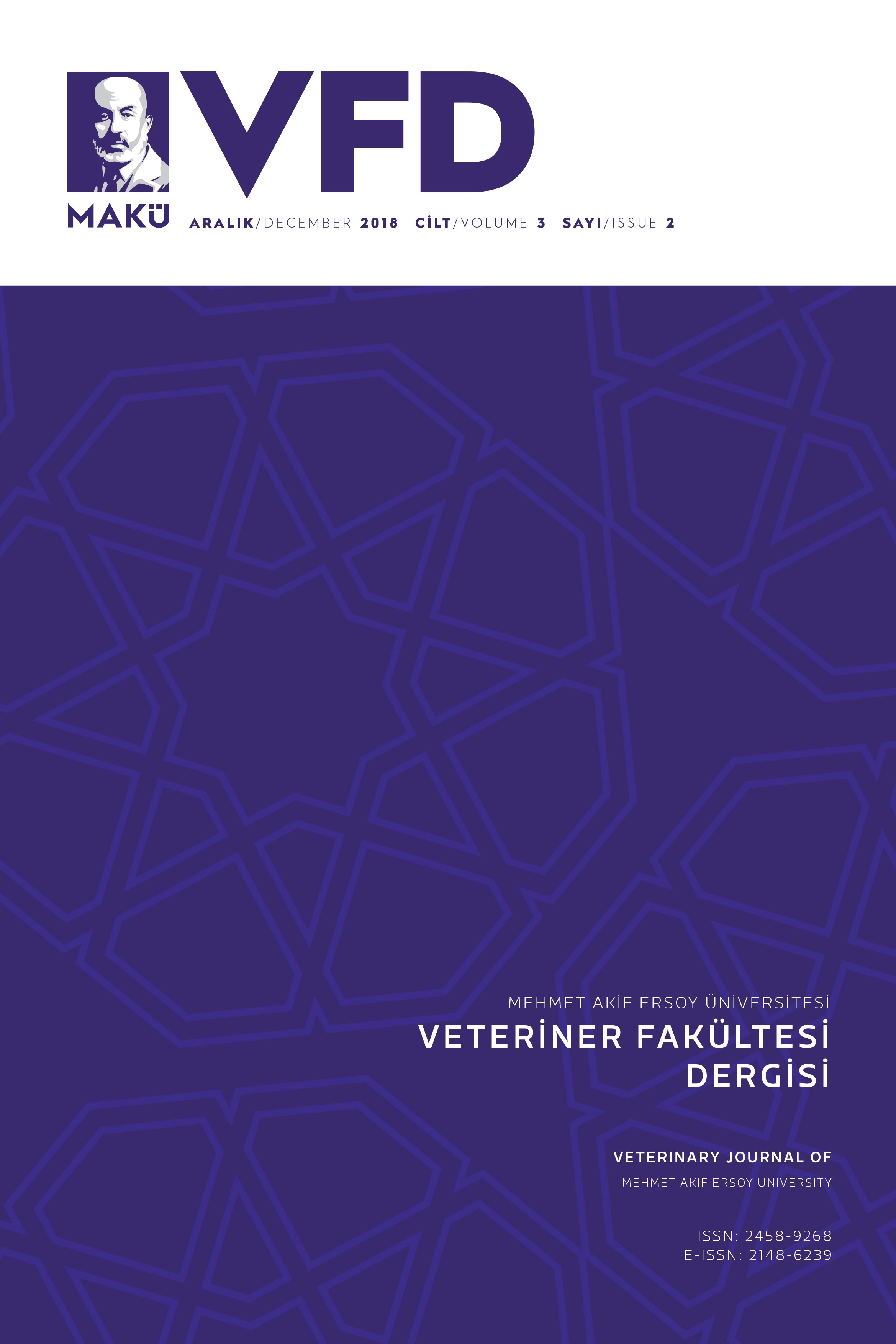Doğal Koşullarda Elde Edilen Alüminyumun Akkaraman Koçlarında Düşük Dozlarda In Vitro Spermatolojik Parametreler Üzerine Etkisi
Alüminyum, Sperma, Koç, Isı Etkisi, Toksikasyon
The Effect of Aluminum Obtained from Natural Conditions on In Vitro Spermatological Parameters at Low Doses in Akkaraman Rams
Aluminum, Sperm, Aries, Heat Effect, Poisoning,
___
- 1. Alfrey, A. C. (1985). Gastrointestinal absorption of aluminum. Clinical nephrology, 24, S84-7.
- 2. Domingo, J. L., Gomez, M., Llobet, J. M., Del Castillo, D., & Corbella, J. (1994). Influence of citric, ascorbic and lactic acids on the gastrointestinal absorption of aluminum in uremic rats. Nephron, 66(1), 108-109.
- 3. Bassioni, G., Mohammed, F. S., Al Zubaidy, E., & Kobrsi, I. (2012). Risk assessment of using aluminum foil in food preparation. Int. J. Electrochem. Sci, 7(5), 4498-4509.
- 4. Greger, J. L., Goetz, W., & Sullivan, D. (1985). Aluminum levels in foods cooked and stored in aluminum pans, trays and foil. Journal of Food Protection, 48(9), 772-777.
- 5. WHO (World Health Organization), “Safety evaluation of certain food additives and contaminants”, WHO Food additives Series 46. Joint FAO/WHO Expert Committee on Food Additives (2001).
- 6. Macrae, R., Robinson, R. K., & Sadler, M. J. (1993). Encyclopaedia of food science, food technology and nutrition.
- 7. Greger, J. L. (1993). Aluminum metabolism. Annual review of nutrition, 13(1), 43-63.
- 8. Krasovskiĭ, G. N., Vasukovich, L. Y., & Chariev, O. G. (1979). Experimental study of biological effects of leads and aluminum following oral administration. Environmental health perspectives, 30, 47-51.
- 9. Domingo, J. L. (1995). Reproductive and developmental toxicity of aluminum: a review. Neurotoxicology and teratology, 17(4), 515-521.
- 10. Yousef, M. I., Kamel, K. I., El-Guendi, M. I., & El-Demerdash, F. M. (2007). An in vitro study on reproductive toxicity of aluminium chloride on rabbit sperm: the protective role of some antioxidants. Toxicology, 239(3), 213-223.
- 11. Varisli, O., Agca, C., & Agca, Y. (2015). Influence of extenders and cooling rates on epididymal sperm of Lewis rat strain.
- 12. Varisli, O., Scott, H., Agca, C., & Agca, Y. (2013). The effects of cooling rates and type of freezing extenders on cryosurvival of rat sperm. Cryobiology, 67(2), 109-116.
- 13. İçme Suyu Temin Edilen Suların Kalitesi ve Arıtılması Hakkında Yönetmelik. 2019/6/ Temmuz. Resmi Gazete(Sayı:30823) Erişim Adresi: https://www.resmigazete.gov.tr/eskiler/2019/07/20190706-8.htm.
- 14. World Health Organization. (2003). Atrazine in drinking-water: background document for development of WHO guidelines for drinking-water quality (No. WHO/SDE/WSH/03.04/32). World Health Organization.
- 15. Ekanem, E. J., et al. (2009). Determination of aluminium in different sources and its contribution to daily dietary intake in Nigeria. Journal of Applied Sciences Research, 5(8), 944-948.
- 16. Bassioni, G., Mohammed, F. S., Al Zubaidy, E., & Kobrsi, I. (2012). Risk assessment of using aluminum foil in food preparation. Int. J. Electrochem. Sci, 7(5), 4498-4509.
- 17. Altmann, P., Cunningham, J., Dhanesha, U., Ballard, M., Thompson, J., & Marsh, F. (1999). Disturbance of cerebral function in people exposed to drinking water contaminated with aluminium sulphate: retrospective study of the Camelford water incident. Bmj, 319(7213), 807-811.
- 18. Ewardson, J. (1992). The Camelford incident. In Second International Conference on Aluminum and Health (pp. 61-64).
- 19. Zhu, Yanzhu, et al. (2012). Suppressive effects of aluminum trichloride on the T lymphocyte immune function of rats. Food and chemical toxicology, 50(3-4), 532-535.
- 20. Varisli, O., Taskin, A., & Akyol, N. (2018). Effects of different extenders and additives on liquid storage of Awassi ram semen. Turkish Journal of Veterinary and Animal Sciences, 42(4), 230-242.
- Başlangıç: 2016
- Yayıncı: Burdur Mehmet Akif Ersoy Üniversitesi
Emin KARAKURT, Hilmi NUHOĞLU, Serpil DAĞ, Aliye GÜLMEZ SAĞLAM, Enver BEYTUT, Mitat ŞAHİN, Salih OTLU, Özgür ÇELEBİ
Ticari kefirlerin bazı kalite parametrelerinin incelenmesi
Gülsüm ÖKSÜZTEPE (ATEŞ), Pelin DEMİR, Pinar KARATEPE, Selçuk ALAN, Müzeyyen AKGÖL
Büyükbaş Hayvancılık İşletmelerinde Yöneticilerin İşgücü Memnuniyet Düzeyleri
Ahmet Cumhur AKIN, Cevat SİPAHİ, Mustafa Bahadır ÇEVRİMLİ, Burak MAT, Aytekin GÜNLÜ
Investigation of antiproliferative effects of Hypericum perforatum oil on myeloma cells
Soner TUTUN, Muhammet Mükerrem KAYA, Melike Sultan USLUER, Hidayet TUTUN
Abdulkadir KAYA, Ömer VARIŞLI, Hüsamettin EKİCİ, Sedat Hamdi KIZIL
Berrin ŞENTÜRK, Aytaç AKÇAY, Savaş SARIÖZKAN
Türkiye’de ithalat kararlarının kırmızı et sektörüne etkisi
Ahmet Cumhur AKIN, Mehmet Saltuk ARİKAN, Mustafa Bahadır ÇEVRİMLİ
Honamlı keçi ırkında Caprine Arthritis Encephalitis Virus (CAEV) enfeksiyonunun araştırılması
